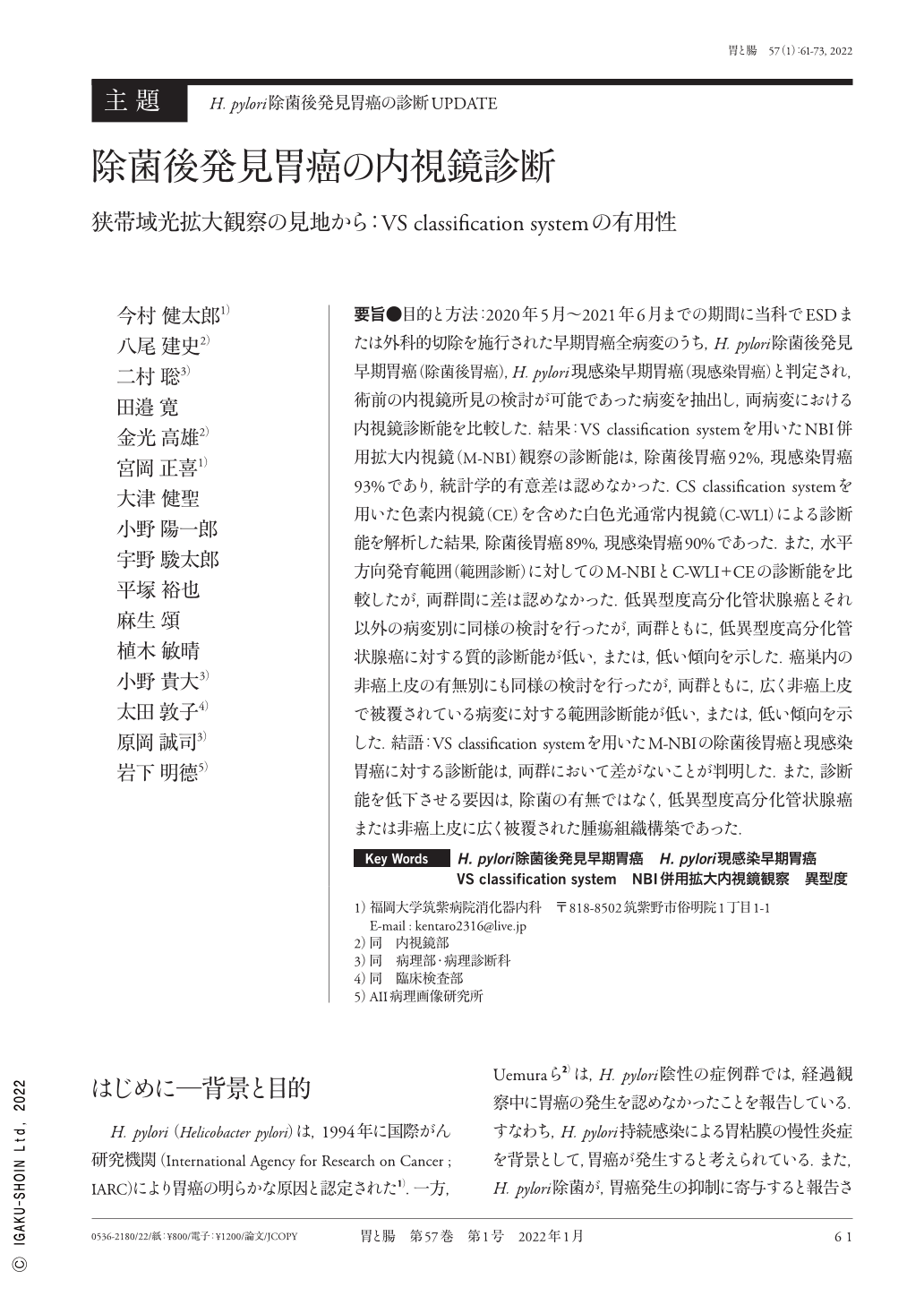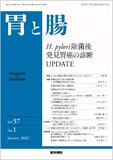Japanese
English
- 有料閲覧
- Abstract 文献概要
- 1ページ目 Look Inside
- 参考文献 Reference
要旨●目的と方法:2020年5月〜2021年6月までの期間に当科でESDまたは外科的切除を施行された早期胃癌全病変のうち,H. pylori除菌後発見早期胃癌(除菌後胃癌),H. pylori現感染早期胃癌(現感染胃癌)と判定され,術前の内視鏡所見の検討が可能であった病変を抽出し,両病変における内視鏡診断能を比較した.結果:VS classification systemを用いたNBI併用拡大内視鏡(M-NBI)観察の診断能は,除菌後胃癌92%,現感染胃癌93%であり,統計学的有意差は認めなかった.CS classification systemを用いた色素内視鏡(CE)を含めた白色光通常内視鏡(C-WLI)による診断能を解析した結果,除菌後胃癌89%,現感染胃癌90%であった.また,水平方向発育範囲(範囲診断)に対してのM-NBIとC-WLI+CEの診断能を比較したが,両群間に差は認めなかった.低異型度高分化管状腺癌とそれ以外の病変別に同様の検討を行ったが,両群ともに,低異型度高分化管状腺癌に対する質的診断能が低い,または,低い傾向を示した.癌巣内の非癌上皮の有無別にも同様の検討を行ったが,両群ともに,広く非癌上皮で被覆されている病変に対する範囲診断能が低い,または,低い傾向を示した.結語:VS classification systemを用いたM-NBIの除菌後胃癌と現感染胃癌に対する診断能は,両群において差がないことが判明した.また,診断能を低下させる要因は,除菌の有無ではなく,低異型度高分化管状腺癌または非癌上皮に広く被覆された腫瘍組織構築であった.
Objectives and methods:The study involved patients with early gastric cancer who had undergone either ESD(endoscopic submucosal dissection)or surgical resection at the Fukuoka University Chikushi Hospital from May 2020 to June 2021. From among these patients, we extracted those who were diagnosed with either early gastric cancer following Helicobacter pylori eradication(eradicated lesions)or early gastric cancer while infected with H. pylori(infected lesions)and whose preoperative endoscopic findings were available for examination. Between the H. pylori-eradicated and H. pylori-infected lesions, endoscopic diagnostic sensitivity were compared.
Results:The lesions analyzed comprised 73 eradicated lesions and 30 infected lesions. The endoscopic diagnostic sensitivity of magnifying endoscopy with M-NBI(narrow-band imaging)using VS(the vessel plus surface)classification system was 92% for the eradicated lesions and 93% for the infected lesions, thus showing no statistically significant differences. The results of an endoscopic diagnostic sensitivity analysis based on conventional C-WLI(white light imaging)methods, including CE(chromoendoscopy)using CS(the color plus surface)classification system, revealed the diagnostic sensitivity to be 89% for the eradicated lesions and 90% for the infected lesions. Moreover, a comparison of diagnostic sensitivity for accurate delineation of tumor margins found no significant differences between M-NBI and C-WLI+CE. Well differentiated tubular adenocarcinoma with low grade atypia and lesions other than those were similarly examined. Consequently, both the eradicated and infected groups exhibited lower diagnostic sensitivity for well differentiated tubular adenocarcinoma with low grade atypia. Further examination was conducted by determining for the presence/absence of noncancerous epithelium in the superficial layer. Subsequently, both the eradicated and infected groups showed lower range diagnostic sensitivity for lesions covered widely with noncancerous epithelium.
Conclusion:No significant differences were noted in the diagnostic sensitivity of M-NBI using the VS classification system between the eradicated and infected gastric cancer lesions. The study also demonstrated that the factor behind lowered diagnostic sensitivity was well differentiated tubular adenocarcinoma with low grade atypia or construction of tumor tissue covered widely with noncancerous epithelium rather than after Helicobacter pylori eradication.

Copyright © 2022, Igaku-Shoin Ltd. All rights reserved.


